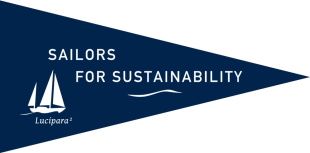Amsterdam (NLD) – Mandal (NOR)
“The rudder is not responding!” Floris panics a bit: we’re “not in command”. The autopilot continuously spins the steering wheel, which should stop after 3 cycles when the rudder has reached its maximum position. Did we lose the rudder? Is there a broken part in the steering system? We are around 100 miles NW of Terschelling, close to the German- Danish (sea)border, but how are we going to get anywhere without an operational rudder?
Nightmare scenarios
Nightmare scenarios cross Floris’ mind, but Ivar stays calm after a quick assessment of our situation. We have daylight, the sea is calm and there are no ships or oilrigs nearby. “Let’s heave to the wind first, so we can quietly explore what is going on.” Heaving to (bijliggen), of course. With only three years of sailing experience, it was not the first thing that came Floris’ mind. Luci slowly turns windward, we tighten the sheets, Luci goes about and is in a stable position. While Ivar turns the steering wheel, Floris climbs below deck to see why the steering wheel is not responding. He immediately sees that a coupling between two pushrods is disconnected – a locking bolt from one of the handlebars seems to be loose. When he puts the rod back into the coupler, Ivar can steer again. With a bolt and duct tape we execute an emergency repair. “Perhaps it is now even more solid than in recent years,” says Ivar. In ten years he has renovated almost everything on the boat, but this part had escaped. We consider ourselves very lucky that we didn’t have this technical incident in a port, storm or near rocks. We put Luci back on course and continue to sail to Norway, relieved yet slightly tense – it was a wake up call that things can always break on a boat.
North to Norway
When Ivar suggested we go on a sailing trip this summer to test out the renovated Luci – Floris was quick to call the destination: Norway! The descriptions and images in the pilot promised us countless islands, anchor bays and spectacular nature. Friends who were in Norway two years ago fueled our enthusiasm. We also wanted to properly test Lucipara after we had completely renovated her and, last but not least, push Floris’ boundaries on the sailing front. He has this fantasy of a fairytale land with breathtaking fjords, abundant nature and wooden houses inhabited by friendly Norwegians. The distance from the Netherlands is a bit daunting: it involves three days of non-stop sailing, more than he has ever done. Floris wonder if it will it be much different than sailing to England, which had been my longest trip so far. Probably not, just longer. Besides, we have to practice for longer trips to come. With plans to cross the Atlantic ocean one day, which would take up to three weeks, three days seems to be a good start. Also, Scandinavia does not feature in the route we have tentatively drawn in our heads for next year’s big trip, so this summer will be our best opportunity to visit the area.
The trip starts well. We leave Amsterdam in the afternoon of 11 July 2015 with sunny weather and moderate southerly wind. The grib files promise at least three days of calm weather with SW and W winds around 4 Beaufort, exactly what we need. Via IJmuiden we pass Noorderhaaks, the buoy VL-7 and from there we sail straight to the Norwegian town of Mandal. The total distance is about 350 miles. We prepare ourselves for the unexpected and discuss that we can interrupt the trip if necessary on the Wadden Sea or in northern Denmark. Fortunately, that proves not to be necessary. After the incident with the steering system Lucipara sails smoothly again, keeping a steady course and moving quietly.
Sailing in Shifts
The first day at 22:00h we start the watch schedule. Until 10:00h in the morning we have three-hour watches, then change to four-hour watches until 22:00h. By doing so, the night watches are less tiring and we automatically change the watches each day. Floris volunteers to take the first “dog watch” from 01:00h to 04:00h. Luci steers herself while Floris reads a good book. Ivar then enjoys the sunrise while Floris finally gets some sleep. His three hours of sleep pass very quickly, so at 07:00h he is still pretty tired when on watch again. Floris looks around and sees some curious birds, but unfortunately that’s all we spot in terms of wildlife. Ships we mainly see on the AIS and in the distance. After a breakfast together, Floris takes another rest. On the first day he has to get used to the rhythm, but from the next day onwards the watches get easier. During the day we enjoy the peace and the wide view together.
